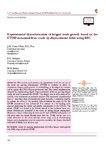Experimental characterisation of fatigue crack growth based on the CTOD measured from crack tip displacement fields using DIC
| dc.contributor.author | Olmo, JMV | |
| dc.contributor.author | Díaz, FA | |
| dc.contributor.author | Antunes, FV | |
| dc.contributor.author | James, Neil | |
| dc.date.accessioned | 2020-07-09T09:50:34Z | |
| dc.date.available | 2020-07-09T09:50:34Z | |
| dc.date.issued | 2019-09-19 | |
| dc.identifier.issn | 1971-8993 | |
| dc.identifier.issn | 1971-8993 | |
| dc.identifier.uri | http://hdl.handle.net/10026.1/15917 | |
| dc.description.abstract |
The current work presents an experimental study on the use of the crack tip opening displacement (CTOD) to evaluate its ability to characterise fatigue crack growth. A methodology is developed to measure and to analyse the CTOD from experimental data. The vertical displacements obtained by implementing digital image correlation (DIC) on growing fatigue cracks are used to measure the CTOD. Two fatigue tests at stress ratios of 0.1 and 0.6 were conducted on compact tension (CT) specimens manufactured from a 1 mm thick sheet of commercially pure titanium. A sensitivity analysis to explore the effect of the position selected behind the crack tip for the CTOD measurement was performed. The analysis of a full loading cycle allowed identifying the elastic and plastic components of the CTOD. The plastic CTOD was found to be directly related to the nonlinear zone (i.e., plastic deformation) generated at the crack tip during fatigue propagation. Moreover, a linear relationship between da/dN and ΔCTODp independent of the stress ratio was found. Results show that the CTOD can be used as a viable alternative to the stress intensity factor range (ΔK) in characterising fatigue crack propagation since the parameter considers the fatigue threshold and crack shielding in an intrinsic way. | |
| dc.format.extent | 658-666 | |
| dc.language.iso | en | |
| dc.publisher | Gruppo Italiano Frattura | |
| dc.title | Experimental characterisation of fatigue crack growth based on the CTOD measured from crack tip displacement fields using DIC | |
| dc.type | journal-article | |
| dc.type | Journal Article | |
| plymouth.issue | 50 | |
| plymouth.volume | 13 | |
| plymouth.publication-status | Published online | |
| plymouth.journal | Frattura ed Integrità Strutturale | |
| dc.identifier.doi | 10.3221/igf-esis.50.56 | |
| plymouth.organisational-group | /Plymouth | |
| plymouth.organisational-group | /Plymouth/Faculty of Science and Engineering | |
| plymouth.organisational-group | /Plymouth/Faculty of Science and Engineering/School of Engineering, Computing and Mathematics | |
| plymouth.organisational-group | /Plymouth/Users by role | |
| plymouth.organisational-group | /Plymouth/Users by role/Academics | |
| dcterms.dateAccepted | 2019-04-23 | |
| dc.rights.embargodate | 2020-7-16 | |
| dc.identifier.eissn | 1971-8993 | |
| dc.rights.embargoperiod | Not known | |
| rioxxterms.versionofrecord | 10.3221/igf-esis.50.56 | |
| rioxxterms.licenseref.uri | http://www.rioxx.net/licenses/all-rights-reserved | |
| rioxxterms.licenseref.startdate | 2019-09-19 | |
| rioxxterms.type | Journal Article/Review |


